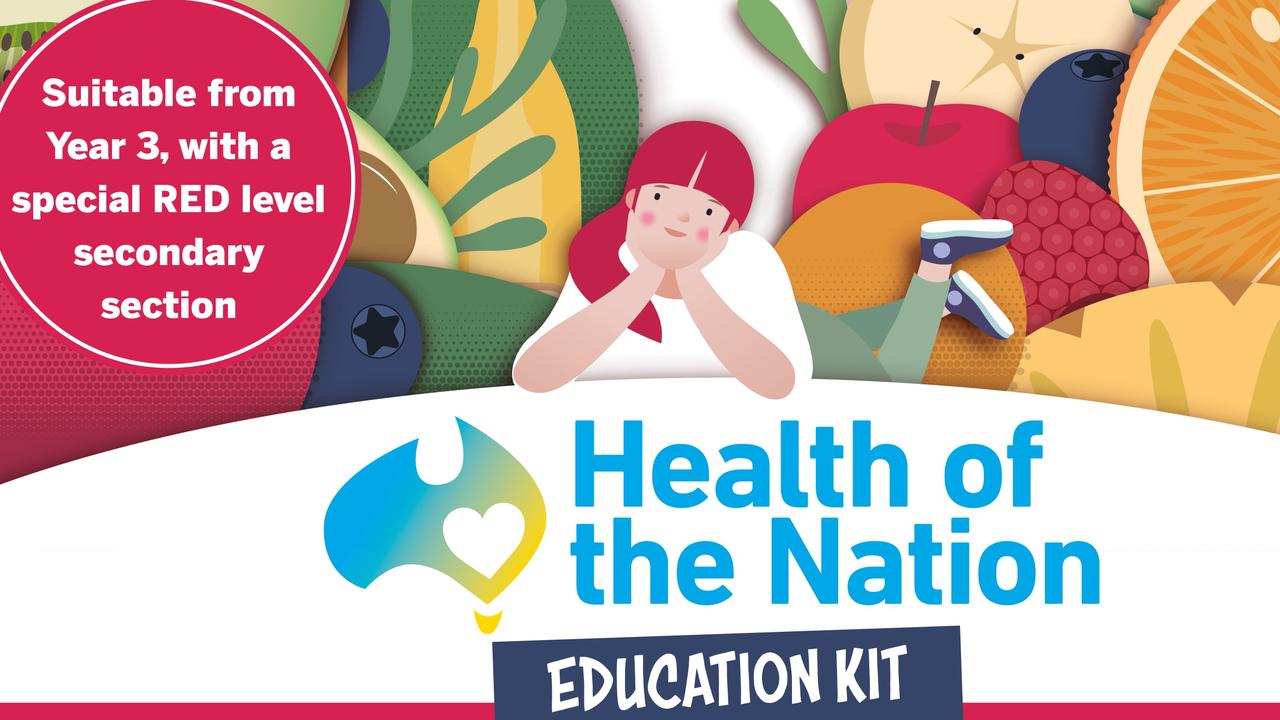Health of the Nation 2024: Learning to appreciate our amazing bodies for what they can achieve
Part 12: A healthy well-fuelled body can help you reach many of your goals in life, but for a lot of us, understanding and challenging how our bodies make us feel can be a tricky chapter

READING LEVEL: RED
Body image is the way we see, think, and behave towards our body, which starts to take shape in early childhood and continues throughout our lifetime.
“Body image is how you feel about how you look and (how you feel) about your body,” said Reach Out clinical lead Linda Williams.
Importantly, good body image means you feel okay about your body generally – and it might mean you sometimes feel confident, and sometimes you don’t.
“Another sign of positive body image is not placing too much importance on your appearance and body but viewing it as only as a part of your identity,” said Ms Williams.
Unhealthy body image is directly related to low self-esteem*, which can lead to anxiety, anger and low mood. Research from the Butterfly Foundation, through Butterfly’s Body Kind Youth Survey, found the majority of young Australians are experiencing body dissatisfaction which significantly* impacts their lives.
The survey findings included that nearly half (45 per cent) of young people are dissatisfied with the way their body looks.
Nearly 70 per cent of young people said they have experienced appearance-related teasing, with 73 per cent of these saying they’d experienced it at school.
Nearly two-thirds of respondents also said their body image stops them from doing physical activities.
“We know that body image concerns can start early and increase during the teenage years, and this report highlights just how high body dissatisfaction and body image concerns are in young people,” said Butterfly Foundation education services manager Helen Bird.

DISORDERED EATING AND EATING DISORDERS
Body dissatisfaction is one of the highest risk factors in the development of an eating disorder. It can also contribute to some young people’s experience with disordered eating*.
“Disordered eating refers to a wide range of eating behaviours that fall along a continuum* between normal eating and an eating disorder,” said clinical psychologist and Butterfly national helpline manager Sarah Cox.
“Disordered eating can take many forms including dieting, regularly skipping meals, inflexible eating patterns, or compulsive* eating.”
These behaviours can be similar to those of an eating disorder; however, disordered eating behaviours are generally less severe and less frequent.

Over time, disordered eating can develop into an eating disorder such as anorexia nervosa (restricting what you eat, leading to low weight), bulimia nervosa (eating large amounts of food and then getting rid of it in unhealthy ways) or binge eating disorder (having a loss of control and overeating).
“Eating disorders are serious psychological illnesses,” Ms Cox said. “They can impact mood, behaviour, energy levels, physical growth and development; reduce ability to concentrate and focus, affecting cognitive* function and learning potential; increase perfectionism/obsession with academic results and other activities; and cause nutritional deficiency*, immune system impairment* and serious and life-threatening physical complications.”
FOOD IS NOT SOMETHING TO FEAR
Indian Australian Varsha Yajman has first-hand experience with an eating disorder, having been diagnosed with anorexia nervosa when she was 16.
“I can’t pinpoint a particular moment when I realised I had an eating disorder,” Ms Yajman, now 21, said.
“It was a collection of incidents – at age seven, I began taking notice of people’s comments about my weight. At 11, I thought feeling hungry was a win, and at 12, I was aware of how I looked compared to other people around me. I was told that my weight, which, according to some, seemed too big on the scale, was an issue to fix.
“At 14, I began to slowly cut down on food and count my calories*, so much so that in one of my final maths exams, my brain could not even focus on the numbers in front of me because I was thinking of the calories I had that day.”

The impact of Ms Yajman’s eating disorder was felt in multiple ways.
“While my weight dropped, so did my relationship with those closest to me, who struggled to understand the complexities of my eating disorder,” she said.
“I was instead reminded of the kids being malnourished* in India and that I should be so grateful to have food. This is not because they did not want to help, or Indian culture is conservative, but because the cultural stigma* around mental health in India, especially for migrants who already have to adapt to a whole new lifestyle, makes it feel almost alien to say ‘I have an eating disorder’,” she said.

Ms Yajman said the process of seeking treatment was complicated, because some health professionals were not supportive or did not understand the mental side of her condition.
“My dietitian, GP and psychologist* were not the most supportive,” she said, “from making me cry in their office to telling me to exercise even though I was struggling with exercise addiction.”
Ms Yajman strengthened the connections with those around her who were truly there to support her, which she said helped.
“Today, my support network is more than I could have ever imagined, and my connection to my culture is growing day by day now that I can centre my day around people and experiences and see food as joy instead of something to fear,” she said.
WHAT ARE SOME SIGNS OF AN EATING DISORDER?
Everyone’s experience of an eating disorder will be unique and it’s not always possible to see the symptoms – eating disorders are mental illnesses. Some people may also have one or a few symptoms.
In general, Ms Cox said some of the common warning signs can include:
Physical warning signs
- Rapid weight loss or frequent weight changes
- Loss or disturbance of menstruation
- Fainting or dizziness
- Feeling tired and not sleeping well; lethargy* and low energy
- Signs of damage due to vomiting including swelling around the cheeks or jaw, calluses* on knuckles, damage to teeth and bad breath
- Feeling cold most of the time, even in warm weather

Psychological warning signs
Psychological warning signs can be difficult to detect in anyone suffering from an eating disorder. They usually only come to light through changes in behaviour or through discussion and conversation.
- Fixation* with eating, food, body shape and weight
- Feeling anxious and or irritable around meal times
- Feeling “out of control” around food
- “Black and white” thinking (e.g. rigid thoughts about food being “good” or “bad”)
- A distorted* body image
- Using food as a source of comfort (e.g. eating as a way to deal with boredom, stress or depression)
- Using food as self-punishment (e.g. refusing to eat due to depression, stress or other emotional reasons)

Behavioural warning signs
Behavioural symptoms are commonly present in those with eating disorders. While you may recognise some of these symptoms in someone you care about, these signs can still be concealed and may be difficult to detect.
- Dieting behaviour (e.g. fasting, counting calories/kilojoules*, avoiding food groups such as fats and carbohydrates)
- Eating in private and avoiding meals with other people
- Evidence of binge eating (e.g. disappearance and/or hoarding* of food)
- Frequent trips to the bathroom during or shortly after meals
- Vomiting or using laxatives* or diet pills
- Changes in clothing style (e.g. wearing baggy clothes)
- Compulsive or excessive exercising (e.g. exercising in bad weather, continuing to exercise when sick or injured, and experiencing distress if exercise is not possible)
- Changes in food preferences (e.g. claiming to dislike foods previously enjoyed, sudden preoccupation with “healthy eating”, or replacing meals with fluids)
- Obsessive rituals around food preparation and eating (e.g. eating very slowly, cutting food into very small pieces, insisting that meals are served at exactly the same time every day)
- Extreme sensitivity to comments about body shape, weight, eating and exercise habits
- Secretive behaviour around food (e.g. saying they have eaten when they haven’t, hiding uneaten food in their rooms)
BE BRAVE AND SPEAK UP
An estimated 1.1 million Australians are living with an eating disorder, according to the Butterfly Foundation, which means most of us will be aware of someone struggling with the condition.
“If you think yourself or your friend might be struggling with their relationship to food, exercise or their body, it’s important to reach out for support to a trusted adult, your school counsellor or wellbeing team, or contact one of the free, confidential helplines to speak to a trained counsellor about what you’re experiencing,” Ms Cox said.
WHO YOU CAN CALL
The Butterfly Foundation: To learn more about eating disorders or body image, visit www.butterfly.org.au
For support with eating disorders or body image concerns, call Butterfly’s National Helpline on 1800 ED HOPE (1800 33 4673), chat online or email support@butterfly.org.au. Counsellors are available seven days a week, 8am-midnight (AEDT) to provide confidential and free advice.
Kids Helpline: 1800 55 1800
POLL
GLOSSARY
- self-esteem: the idea of feeling good about yourself
- significantly: having great importance
- disordered eating: a wide range of eating behaviours that fall between normal eating and an eating disorder (which is a mental health condition involving an unhealthy relationship with food)
- continuum: something the keeps going but slowly changes over time
- compulsive: not being able to stop doing something wrong, harmful, or unnecessary
- cognitive: the ability to think and reason
- deficiency: lacking something
- impairment: a loss of function or ability
- calories: a measure of energy we can get from something we eat or drink
- malnourished: not having enough nutrients or food for essential growth
- stigma: unfair or negative beliefs in society
- psychologist: a doctor who studies the way people think, feel, and behave
- lethargy: having no energy
- calluses: hard skin caused by rubbing or pressure
- fixation: thinking about it all the time
- distorted: to twist out of shape and change the way something looks
- kilojoules: a measure of energy we can get from something we eat or drink
- hoarding: the urge to collect and keep a huge amount of stuff
- laxatives: medicines that help you poo when your bowels aren’t working
QUICK QUIZ
1. What are the signs that a person has a positive body image of themselves?
2. What is disordered eating and what can it develop into?
3. Behavioural symptoms are commonly present in those with eating disorders. Can you name four?
4. Describe the phases Varsha Yajman went through as a tween and teen before she was diagnosed with anorexia nervosa at 16.
5. Approximately how many Australians are living with an eating disorder in 2024?
LISTEN TO THIS STORY
CLASSROOM ACTIVITIES
Kids News has produced a free Health of the Nation education kit full of classroom activities to support the information and expert advice in this series.
It has been crafted by one of our expert Kids News teachers and in 12 parts, it breaks down the steps needed for overall good health in children.
Sign up free to the Kids News weekly newsletter HERE to access the education kit plus more news and initiatives.
EXTRA READING
Sleep app boosts teens’ mental health


